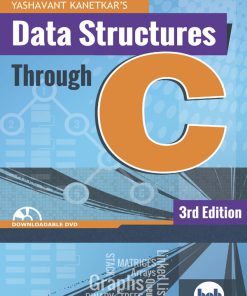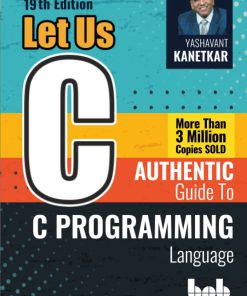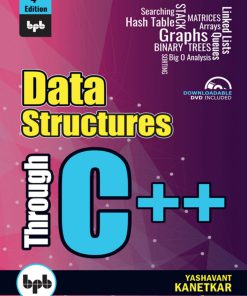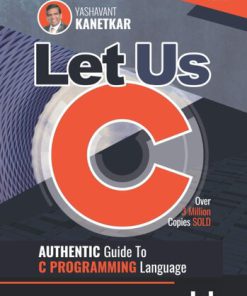Let Us C (17th Ed.) SOLUTIONS: Authentic Solutions To Let US C Exercises 17th Edition by Yashavant Kanetkar 9789389845693 9389845696
$50.00 Original price was: $50.00.$25.00Current price is: $25.00.
Let Us C (17th Ed.) SOLUTIONS: Authentic Solutions To Let US C Exercises 17th Edition Yashavant Kanetkar – Ebook Instant Download/Delivery ISBN(s): 9789389845693, 9389845696
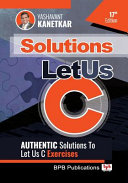
Product details:
- ISBN 10:9389845696
- ISBN 13:9789389845693
- Author: Yashavant Kanetkar
Let Us C: Authentic Guide to C PROGRAMMING Language
Table contents:
1. Getting Started
What is C?
Getting Started with C
Alphabets, Digits and Special Symbols
Constants, Variables and Keywords
Types of Constants
Rules for Constructing Integer Constants
Rules for Constructing Real Constants
Rules for Constructing Character Constants
Types of C Variables
Rules for Constructing Variable Names
C Keywords
The First C Program
Form of a C Program
Comments in a C Program
What is main()?
Variables and their Usage
printf() and its Purpose
Compilation and Execution
Receiving Input
Programs
Exercises
KanNotes
2. C Instructions
Types of Instructions
Type Declaration Instruction
Arithmetic Instruction
Integer and Float Conversions
Type Conversion in Assignments
Hierarchy of Operations
Associativity of Operators
Control Instructions
Programs
Exercises
KanNotes
3. Decision Control Instruction
The if – else Statement
Multiple Statements within if – else
Nested if-elses
A Word of Caution
Programs
Exercises
KanNotes
4. More Complex Decision Making
Use of Logical Operators – Checking Ranges
The else if Clause
Use of Logical Operators – Yes / No Problem
The ! Operator
Hierarchy of Operators Revisited
The Conditional Operators
Programs
Exercises
KanNotes
5. Loop Control Instruction
Loops
The while Loop
Tips and Traps
More Operators
Programs
Exercises
KanNotes
6. More Complex Repetitions
The for Loop
Nesting of Loops
Multiple Initializations in the for Loop
The break Statement
The continue Statement
The do-while Loop
The Odd Loop
Programs
Exercises
KanNotes
7. Case Control Instruction
Decisions using switch
The Tips and Traps
switch versus if-else Ladder
The goto Keyword
Programs
Exercises
KanNotes
8. Functions
What is a Function?
Why use Functions?
Passing Values between Functions
Order of Passing Arguments
Using Library Functions
One Dicey Issue
Return Type of Function
Programs
Exercises
KanNotes
9. Pointers
Call by Value and Call by Reference
An Introduction to Pointers
Back to Function Calls
Conclusions
Programs
Exercises
KanNotes
10. Recursion
Recursion
Programs
Exercises
KanNotes
11. Data Types Revisited
Integers—long, short, signed, unsigned
Chars—signed, unsigned
Reals—float, double, long double
A Few More Issues…
Storage Classes in C
Automatic Storage Class
Register Storage Class
Static Storage Class
External Storage Class
A Few Subtle Issues
Which to Use When
Exercises
KanNotes
12. The C Preprocessor
Features of C Preprocessor
Macro Expansion
Macros with Arguments
Macros versus Functions
File Inclusion
Conditional Compilation
#if and #elif Directives
Miscellaneous Directives
#undef Directive
#pragma Directive
The Build Process
Programs
Exercises
KanNotes
13. Arrays
What are Arrays?
A Simple Program using Array
More on Arrays
Array Initialization
Array Elements in Memory
Bounds Checking
Passing Array Elements to a Function
Pointers and Arrays
Accessing Array Elements using Pointers
Passing an Array to a Function
Flexible Arrays
Programs
Exercises
KanNotes
14. Multidimensional Arrays
Two-Dimensional Arrays
Initializing a 2-D Array
Memory Map of a 2-D Array
Pointers and 2-D Arrays
Pointer to an Array
Passing 2-D Array to a Function
Array of Pointers
3-D Array
Programs
Exercises
KanNotes
15. Strings
What are Strings
More about Strings
Pointers and Strings
Standard Library String Functions
strlen()
strcpy()
strcat()
strcmp()
Programs
Exercises
KanNotes
16. Handling Multiple Strings
2-D Array of Characters
Array of Pointers to Strings
Limitation of Array of Pointers to Strings
Programs
Exercises
KanNotes
17. Structures
Why use Structures?
Array of Structures
Intricacies of Structures
Structure Declaration
Storage of Structure Elements
Copying of Structure Elements
Nested Structures
Passing Structure Elements / Structure Variables
Packing Structure Elements
Uses of Structures
Programs
Exercises
KanNotes
18. Console Input/Output
Types of I/O
Console I/O Functions
Formatted Console I/O Functions
sprintf() and sscanf() Functions
Unformatted Console I/O Functions
Exercises
KanNotes
19. File Input/Output
File Operations
Opening a File
Reading from a File
Closing the File
Counting Characters, Tabs, Spaces, …
A File-Copy Program
File Opening Modes
String (Line) I/O in Files
Text Files and Binary Files
Record I/O in Files
Modifying Records
Low-Level File I/O
A Low-Level File-Copy Program
Programs
Exercises
KanNotes
20. More Issues In Input/Output
Using argc and argv
Detecting Errors in Reading/Writing
Standard File Pointers
I/O Redirection
Redirecting the Output
Redirecting the Input
Both Ways at Once
Exercises
KanNotes
21. Operations On Bits
Bit Numbering and Conversion
Bit Operations
One’s Complement Operator
Right Shift and Left Shift Operators
A Word of Caution
Utility of << Operator
Bitwise AND, OR and XOR Operators
Utility of & Operator
Utility of | Operator
Utility of ^ Operator
The showbits() Function
Bitwise Compound Assignment Operators
Programs
Exercises
KanNotes
22. Miscellaneous Features
Enumerated Data Type
Uses of Enumerated Data Type
Are Enums Necessary?
Renaming Data Types with typedef
Typecasting
Bit Fields
Pointers to Functions
Functions Returning Pointers
Functions with Variable Number of Arguments
Unions
Utility of Unions
The volatile Qualifier
Programs
Exercises
KanNotes
23. Interview FAQs
People also search:
let us c (17th ed.) solutions: authentic solutions
let us c 17th edition solutions pdf
You may also like…
Computers - Programming
Let Us C Solutions 19th Edition Authentic Solutions to Let Us C Exercises Yeshwant Kanetkar
Computers - Algorithms and Data Structures
Data Structures Through C 3rd Ed 1st Edition Yashavant Kanetkar
Computers - Programming
Computers - Programming
Let Us Python 3rd Ed 3rd Edition by Yashavan 9389898528 9789389898521t, Aditya
Religion & Spirituality - Christianity
Computers - Programming
Let Us Python 5th Edition by Yashavant Kanetkar, Aditya Kanetkar ISBN 9789355511850 935551185X
Computers - Programming
Let Us C Authentic guide to C programming language 19th Edition Yashavant Kanetkar
Computers - Algorithms and Data Structures
Data Structures Through C++ 4th Editon by Yashavant Kanetkar ISBN 9789355511881 9355511884
Computers - Programming
Let Us C 17th Edition by Yashavant Kanetkar ISBN 9389845688 9789389845686





